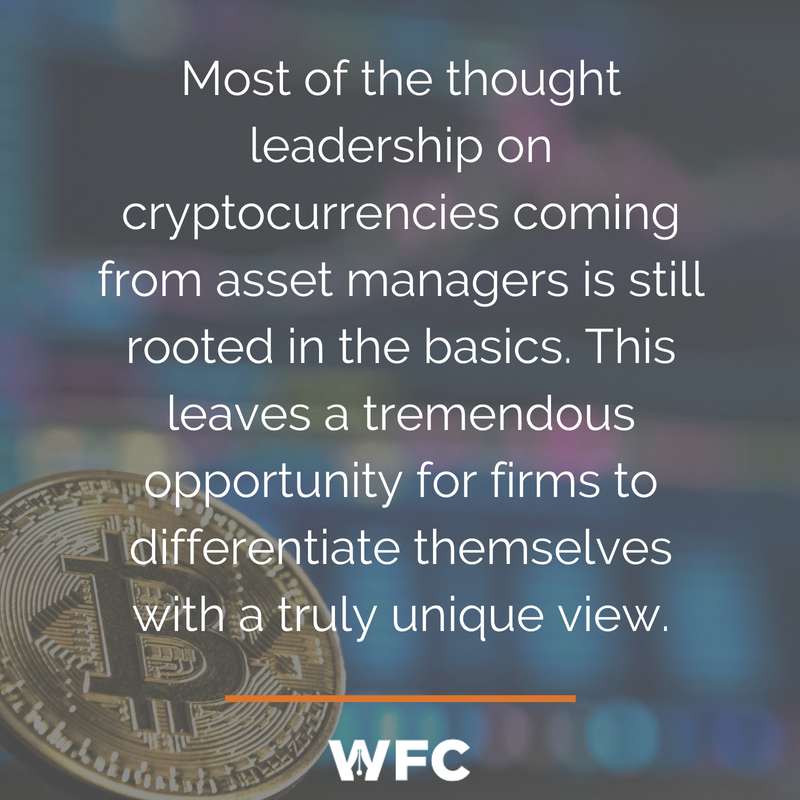Bitcoin. Blockchain. Ether. Ethereum.
These are terms that, just a few short years ago, were meaningless to most people in financial services and asset management, not to mention the world at large. Nowadays, these terms, for many in finance and beyond, represent the future of financial innovation.
These terms are various cryptocurrencies and the technology that underpins their value. Think of them as money 2.0.
And now that the world of cryptocurrencies and blockchain technology are going mainstream—with asset managers and other players in the financial ecosystem exploring how to incorporate this potentially innovative asset class into their long-term investment strategies—financial marketers are writing more and more on the topic.
The problem is most of the thought leadership on cryptocurrencies and blockchain technology coming from asset managers is still rooted in the basics. Much of the content we see simply tries to provide a primer on what cryptocurrencies are and how blockchain works. This leaves a tremendous opportunity for firms to differentiate themselves with a truly unique view.
On August 8, Wentworth Financial Communications attended an event organized by the Chicago chapter of the CFA Society about what institutional asset managers need to know about the dynamics of cryptocurrency investing. The event featured Ari Paul, CFA, a cryptocurrency investor and expert who previously served as a portfolio and risk manager for The University of Chicago’s $7.5 billion endowment.
Paul’s talk covered several interesting aspects of cryptocurrencies’ past and future and offered a nuanced look at some of the opportunities and challenges they present as an asset class. Here are four unique angles from Paul’s talk that financial marketers should consider writing about as they continue publishing thought leadership on cryptocurrencies.
Focus on the problems cryptocurrencies may solve, not the day-to-day volatility of the asset
Most of the press coverage on cryptocurrencies of late has focused on the tremendous volatility of cryptocurrencies like bitcoin—which saw its value increase dramatically at the end of 2017 to nearly $20,000 before losing about half of its value at the start of 2018 when speculative investors rushed in and then out of crypto-mania. (As of this writing, bitcoin is valued at about $6,500.)
What isn’t getting enough attention, according to Paul, are the problems that bitcoin and other cryptocurrencies are trying to solve.
Most people assume that the financial system works just fine, with traditional, “fiat currencies,” such as the U.S. dollar or the euro, being an adequate, stable currency. But as Paul and other cryptocurrency advocates argue—and as financial marketers might consider writing about in their thought leadership—basing the banking system on fiat currencies is, as Paul put it, “comically obsolete.”
Most money today is entirely digital; however, the banking system still relies on antiquated technology based on the movement of physical assets to facilitate payments and transfers. Cryptocurrencies, like bitcoin, aim to bring banking technology into the 21st Century and beyond by introducing a more frictionless, transparent, and decentralized system to market.
The chief example of this is the blockchain, which is a decentralized, transparent, ledger network where cryptocurrencies are mined and exchanged. Think of it as the Internet of money, contracts, and other vital transactions. For example, Paul said a more transparent and public ledger, if adopted by mainstream financial institutions, would enable regulators to more effectively monitor and prevent financial fraud and wrongdoing.
Another problem cryptocurrencies were designed to solve is protection against government-manipulation and inflation risk. Because bitcoin, ether, and other cryptocurrencies are decentralized, they are immune to the traditional inflation risk of fiat currencies, whereas governments control the supply of money through a centralized banking system.
Governments, through their central banks, can raise or lower interest rates on government bonds—and therefore control the supply of fiat money in circulation—and thus manipulate the value of the dollar, or any other currency. Conversely, many cryptocurrencies’ supply is fixed at a pre-determined, projected amount. Crypto proponents argue that the decentralized, algorithmic nature of cryptocurrencies ensures that each asset’s store of value is less vulnerable to artificial manipulation by a single institution or entity.
Write less about bitcoin and more about lesser-known ‘altcoins’
There’s no doubt that bitcoin is the darling of cryptocurrencies, but the reason other cryptocurrencies, dubbed “altcoins,” exist is that bitcoin has many shortcomings. Bitcoin gets the majority of attention because it has a first-mover advantage. But just as Yahoo preceded Google as the world’s first Internet search engine, bitcoin may not necessarily end up being the most valuable cryptocurrency in the future.
While bitcoin certainly has its strengths, there are other, lesser-known cryptocurrencies that may prove to have a better, long-term use for traditional financial services firms—and therefore might make better investments for asset managers.
Stellar and ripple are two examples, according to Paul, that have the potential to transform international banking. Ripple, for example, is a real-time gross settlement system, currency exchange, and remittance network that aims to make cross-border transactions more seamless, accessible, and affordable to the masses. Stellar is an open-source protocol for value exchange that looks to create cheaper and faster transactions.

As Paul pointed out, both are a threat to traditional firms like Western Union, which charge high fees to transfer fiat currencies across borders at a much slower pace.
Stellar and ripple are two of many altcoins proliferating the cryptocurrency market. Because these so-called altcoins don’t have the same mainstream notoriety as bitcoin, fewer asset managers are writing about them—meaning you have a better chance of standing out from the crowd by publishing thought leadership that truly advances the conversation.
Write about the downsides of cryptocurrencies not to delegitimize them, but to point out potential untapped opportunities
To say that cryptocurrencies are a polarizing topic among investment professionals is an understatement. With so much excitement around the idea of cryptocurrencies and the technology behind them, there certainly is a large—and in some cases, very vocal—portion of the investment community who are quick to dismiss them outright without going into further detail or nuance. As a result, there’s a dearth of measured, objective talk about the legitimate barriers to widespread adoption outside of cryptocurrencies.
At the CFA event, Paul tried to fill this void by going into detail about the nuanced barriers facing the cryptocurrency market.
For example, there are currently inadequate solutions when it comes to safeguarding cryptocurrencies. Stealing fiat money from someone’s bank account is hard; cryptocurrencies are far more vulnerable to hackers or other security breaches.
Additionally, Paul said cryptocurrency exchanges still come with plenty of counterparty risk, meaning there’s little clarity about whom people are buying from on the other end of a transaction.
Furthermore, many initial coin offerings, or ICOs—where companies offer tokens to the public to fund the creation of a product or service to be redeemed for a discounted future purchase of that product or service—are outright scams.
The cryptocurrency industry has only recently established a pool of credible, reliable experts on the market, as traditional investment institutions are beginning to publish formal sell-side research.
Financial marketers have the opportunity to write about potential solutions to these and other vulnerabilities as a way to stand out from a crowd of skeptics.
Identify the companies and investment opportunities that stand to benefit from the rise of cryptocurrencies
Finally, instead of writing about cryptocurrencies themselves, financial marketers should identify which companies, products, commodities, and services stand to benefit from the rise of cryptocurrencies and blockchain technology.
For example, which computing or network-technology companies could benefit from an increase in competitiveness of cryptocurrency mining, which would require a substantial investment in computing hardware and other technology infrastructure? Moreover, how will the increasing proliferation of cryptocurrencies influence the supply and demand of other, under-the-radar commodities?
Many indirect investment opportunities will emerge with the success—or failure—of the cryptocurrency market. Financial marketers who choose to write about them may be positioning themselves as true thought leaders in a space that is captivating investors around the world.
Meanwhile, for more insights on the world of financial-industry thought leadership, subscribe to our YouTube page.
About the Author

Frank Kalman is the chief operations officer at Wentworth Financial Communications. Frank and the team of writers and editors at WFC help professionals across the financial services industry build their brands by creating investment-grade white papers, bylined articles, newsletters, blogs, social media posts, and other forms of content marketing.
